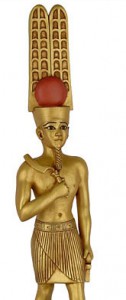Amen’s name means “The Hidden One.” Amen was the patron deity of the city of Thebes from earliest times, and was viewed (along with his consort Amenet) as a primordial creation-deity by the priests of Hermopolis. His sacred animals were the goose and the ram.
 Up to the Middle Kingdom Amen was merely a local god in Thebes; but when the Thebans had established their sovereignty in Egypt, Amen became a prominent deity, and by Dynasty XVIII was termed the King of the Gods. His famous temple, Karnak, is the largest religious structure ever built by man. According to Budge, Amen by Dynasty XIX-XX was thought of as “an invisible creative power which was the source of all life in heaven, and on the earth, and in the great deep, and in the Underworld, and which made itself manifest under the form of Ra.” Additionally, Amen appears to have been the protector of any pious devotee in need.
Up to the Middle Kingdom Amen was merely a local god in Thebes; but when the Thebans had established their sovereignty in Egypt, Amen became a prominent deity, and by Dynasty XVIII was termed the King of the Gods. His famous temple, Karnak, is the largest religious structure ever built by man. According to Budge, Amen by Dynasty XIX-XX was thought of as “an invisible creative power which was the source of all life in heaven, and on the earth, and in the great deep, and in the Underworld, and which made itself manifest under the form of Ra.” Additionally, Amen appears to have been the protector of any pious devotee in need.
Amen was self-created, according to later traditions; according to the older Theban traditions, Amen was created by Thoth as one of the eight primordial deities of creation (Amen, Amenet, Heq, Heqet, Nun, Naunet, Kau, Kauket). During the New Kingdom, Amen’s consort was Mut, “Mother,” who seems to have been the Egyptian equivalent of the “Great Mother” archetype. The two thus formed a pair reminiscent of the God and Goddess of other traditions such as Wicca. Their child was the moon god Khons.